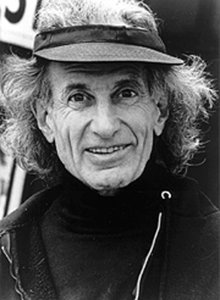Henry Brant facts for kids
Quick facts for kids
Henry Brant
|
|
|---|---|
 |
|
| Born | September 15, 1913 |
| Died | April 26, 2008 (aged 94) Santa Barbara, California, United States
|
| Occupation | Composer, orchestrator, instrumentalist |
Henry Dreyfuss Brant (born September 15, 1913 – died April 26, 2008) was a composer from Canada who later became an American citizen. He was really good at arranging music for orchestras. Many of his musical pieces used a special technique called spatial music. This means he thought about where the sounds came from in a room.
Contents
A Life in Music
Henry Brant was born in Montreal, Canada, in 1913. His parents were American, and his father was a violinist. Henry was a child prodigy, meaning he was super talented from a young age. He started composing music when he was just eight years old!
He studied music at the McGill Conservatorium and later in New York City. Henry could play many instruments very well. These included the violin, flute, piano, organ, and drums. He also understood how to play all the instruments in an orchestra.
When he was only 19, Henry Brant was the youngest composer in a famous book. This book, called American Composers on American Music, was written by Henry Cowell. Cowell noticed that Brant was already exploring new and experimental music ideas.
Later, Brant composed, arranged, and conducted music for many different things. He worked on radio shows, movies, ballets, and even jazz groups. All these experiences helped him create his unique style of music later on. He also taught music at famous schools like Columbia University and the Juilliard School. He taught for 24 years at Bennington College.
Exploring Spatial Music
In the mid-1950s, Henry Brant had a big idea about music. He felt that music with just one style couldn't show the complex feelings of modern life. He wanted to create music that had many different sounds and styles happening at the same time.
To do this, Brant started experimenting with spatial music. This is where the physical location of instruments or singers in a room becomes a key part of the music. Imagine different groups of musicians placed all around a concert hall, not just on stage! This was a new way to make music.
Brant believed that space was like a "fourth dimension" in music. The other dimensions are pitch (how high or low a note is), time (the rhythm), and timbre (the sound quality of an instrument). By placing musicians in different spots, he could make the music sound clearer and more exciting. He wrote over 100 spatial music pieces.
His larger works often used many different groups of performers. For example, in his piece Meteor Farm, he used a symphony orchestra, a jazz band, two choirs, and even African and Indian drum groups! He also wrote pieces for many of the same instrument. Imagine Orbits for 80 trombones, an organ, and a high-pitched voice!
Henry Brant also worked in Hollywood. He arranged music for many movies, including the famous film Cleopatra (1963). He helped other famous composers like Alex North and Aaron Copland with their music. Brant was also inspired by the composer Charles Ives. Ives's piece The Unanswered Question was a big influence on Brant's spatial music.
From 1981, Brant lived in Santa Barbara, California. He passed away there on April 26, 2008, at 94 years old.
Notable Works and Recognition
Henry Brant is well-known for his spatial compositions. Some of his famous pieces include Verticals Ascending and Horizontals Extending. He also created a "spatial opera" called The Grand Universal Circus in 1956.
In 2002, Henry Brant won the very important Pulitzer Prize for Music. He received this award for his composition called Ice Field. He often played solo parts in his own large musical works.
His last major premieres included Wind, Water, Clouds & Fire in 2004, and Tremors in 2004. Ghosts & Gargoyles, a concerto for flute, premiered in 2002.
After he passed away, a book he wrote about arranging music, called Textures and Timbres, was published.
Spatial Works
- Orbits: A Spatial Symphonic Ritual (for 80 trombones, organ and sopranino voice) (1979)
- Autumn Hurricanes, A Spatial Cantata for Widely Separated Vocal and Instrumental Groups (1986)
- Antiphony I
- Desert Forests (2000)
- Ice Field
- On the Nature of Things (1956)
- Plowshares and Swords
- Prisons of the Mind
- Trinity of Spheres
Awards and Honors
Henry Brant was a member of the American Academy of Arts and Letters. Besides the Pulitzer Prize for Music, he received many other important awards. He won two Guggenheim Fellowships. He was also the first American composer to win the Prix Italia.
Other honors included awards from the Ford Foundation and the National Endowment for the Arts. In 1998, Wesleyan University gave him an honorary degree. This was to celebrate his 85th birthday. Also in 1998, a special foundation in Switzerland bought all of Brant's original music papers. This collection includes over 300 of his works.

